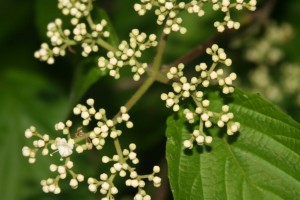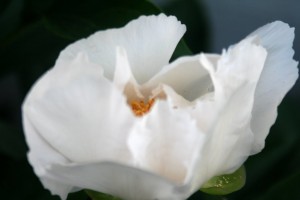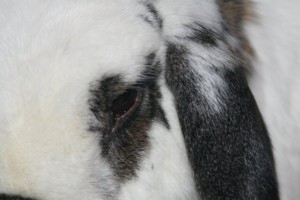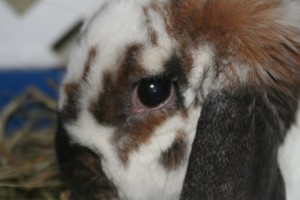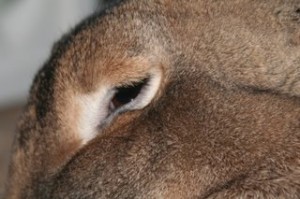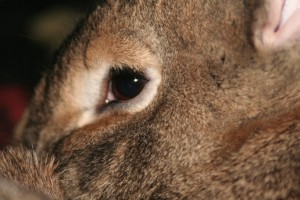This photo of Cricket shows a pose that is very familiar to bunny owners. When a bunny is feeling particularly content and safe they will stretch all the way out with their feet behind them. A bunny can’t get away quickly when they’re in this position; in fact my big guys scrabble and slide around on the floor for a bit before they manage to get upright. Bunny people call this “happy feet” and think of it as the ultimate form of bunny relaxation.
Monthly Archives: May 2006
whorled leaves reading group
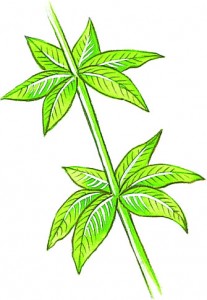 Just in case you haven’t already checked it out – have a look at the whorled leaves blog (linked also on my sidebar) where I’m a member and occasionally post. Whorled Leaves is a great community of thoughtful readers that look for inspiration from the natural world and from good books about the natural world.
Just in case you haven’t already checked it out – have a look at the whorled leaves blog (linked also on my sidebar) where I’m a member and occasionally post. Whorled Leaves is a great community of thoughtful readers that look for inspiration from the natural world and from good books about the natural world.
Each member has a chance to suggest books for the upcoming month. July is my month and I’ve just posted my selections. Have a look and please participate there also with your ideas.
In praise of Viburnums
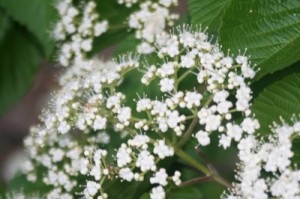
Viburnums, like this Linden Viburnum (Viburnum dilatatum) are my favorite woody shrubs. I love the way they bloom and are smothered in a veil of creamy white. The tiny flowers attract a nice variety of insects and in a good year they are covered with bright red berries in the fall. Their habit is upright and somewhat stiff; mine are massed in a group of three along the property line.
We moved these as mature plants when we put in the pond and just this year they seem to be coming in to their own again in leaf and flower, although they are in a more shaded location. We also used to have a doublefile viburnum, which was drop-dead gorgeous in bloom (but sterile), unfortunately that one did not survive the move. In its place, I’ve repeatedly planted another favorite viburnum: Smooth Witherod (Viburnum nudum) that has gorgeous pinkish/purple berries, but I can’t seem to keep them alive. Of the two planted last fall, one is clearly dead and the other is struggling and has only managed to put out a half-dozen leaves. I’ll have to decide what to replace them with; I’m thinking about a Cranberrybush Viburnum (Viburnum trilobum) which has a more *wild* habit, but beautiful fruit that is loved by birds.
If there is room for yet another plant in your shrub border, there is sure to be a variety of Viburnum that will suit your site – and the birds and bugs will thank you. 
Blushing peony
Along the Navesink
I went to the river today hoping for a breeze – summer seems to have arrived overnight. With summer in NJ comes overbearing humidity. Yuck. There was enough wind for a few sailboats to be out and many families were at the marina for probably the first time this season, readying for a day trip on the river to Sandy Hook or NY Harbor. A few kids were crabbing from the dock – seems a bit optimistic to me so early in the season. I was surprised to find barn swallows here, twisting and turning low over the water between the moored boats. I got only one pic before a swallow flew too close for it to have been an accident – it perched on the railing of the boat in the foreground and chittered at me for a moment. Once I backed off, it flew from the railing to the underside of the stairway leading down to the dock where it had made a nest over the water. Quite a surprise!
Do you hear what I hear?
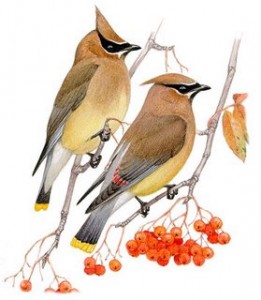 This story on NPR today made me chuckle – the things teenagers will do to confound adults! I know that I hear birdsong better than non-birders, simply because my ears are *trained* to hear what distinguishes one birdsong from another, but this story reminded me that not all birders are able to hear all birdsongs. As we age, our ability to hear high-pitched sounds decreases. In my mid-thirties, I can hear the very high and thin notes of a flock of cedar waxwings, but as I age I will likely lose this ability to hear their “seeeeeee” notes. The high upslurred notes at the end of a Blackburnian’s song are also hard to hear if your ears are less sensitive.
This story on NPR today made me chuckle – the things teenagers will do to confound adults! I know that I hear birdsong better than non-birders, simply because my ears are *trained* to hear what distinguishes one birdsong from another, but this story reminded me that not all birders are able to hear all birdsongs. As we age, our ability to hear high-pitched sounds decreases. In my mid-thirties, I can hear the very high and thin notes of a flock of cedar waxwings, but as I age I will likely lose this ability to hear their “seeeeeee” notes. The high upslurred notes at the end of a Blackburnian’s song are also hard to hear if your ears are less sensitive.
Small flocks of cedar waxwings accompanied the dog and I on our evening walk today. They were congregating in the black locust trees in the neighborhood, attracted by the many insects, I guess. I’ve also noticed that hummingbirds seem to have a fondness for locust trees, at least the ones in the grove at Sandy Hook’s North Pond.
Spring pond pics and new friends
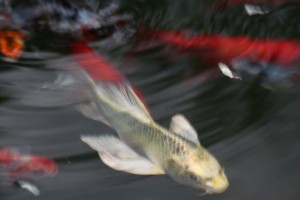 I gave in and let my husband add a few koi to our pond last week. I’d been adamant about not wanting koi because I’d read that they’ll tear up and root around in all of the pond plants. Yet, he convinced me to give it a go and so we did. I picked out a nicely-colored gold and yellow koi who has been hiding under the waterfall since we brought them home. This white butterfly koi in the photo, on the other hand, is a show-stealer! It swims on the surface showing off its lovely long fins and stealing your attention from the less fancy fish. Another of the koi seems to be slightly off-kilter or crazed; it swims along the bottom of the pond and twists itself against the creases in the liner and occasionaly jumps out of t
I gave in and let my husband add a few koi to our pond last week. I’d been adamant about not wanting koi because I’d read that they’ll tear up and root around in all of the pond plants. Yet, he convinced me to give it a go and so we did. I picked out a nicely-colored gold and yellow koi who has been hiding under the waterfall since we brought them home. This white butterfly koi in the photo, on the other hand, is a show-stealer! It swims on the surface showing off its lovely long fins and stealing your attention from the less fancy fish. Another of the koi seems to be slightly off-kilter or crazed; it swims along the bottom of the pond and twists itself against the creases in the liner and occasionaly jumps out of t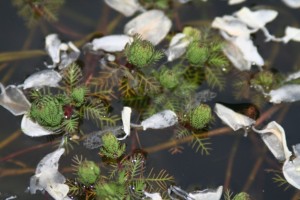 he water!
he water!
I mentioned earlier in the week that the locust trees are blooming. They’ve now started dropping petals everywhere; mostly in the pond, it seems. The effect is pretty, even if it does require a daily skimming with the net. Last year around Memorial Day I had lilies blooming, but this year it will be later because I only just replaced the plants that died over the winter. The plant at right is Parrot’s Feather, which the new fish seem to 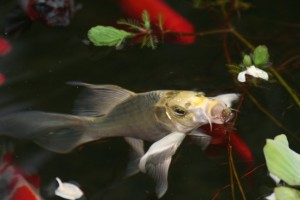 enjoy munching on. I bought a small plant to provide some cover for the fish, knowing that it will grow and spread by mid-summer. It’s an interesting plant in that the feathery foliage closes up late in the day.
enjoy munching on. I bought a small plant to provide some cover for the fish, knowing that it will grow and spread by mid-summer. It’s an interesting plant in that the feathery foliage closes up late in the day.
We’ve also attracted another frog to the pond. At least I think this is a different one than the one we found when we did our spring clean-up. This one seems a bit smaller and greener than the last one. Late in the afternoon I find him peeping at me from between the rocks under the hosta plants and mint that line one side of the pond. I’m not sure what he’s finding to eat. I hope his presence isn’t the explanation for a few fish that have vanished in the last few weeks. Very seldom do I find a fish floating; 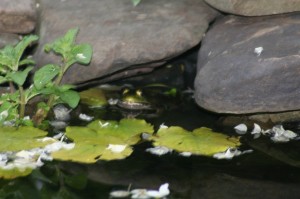 they just disappear. Last summer we had *issues* with a very large bullfrog eating our goldfish. I never would have believed his mouth big enough until one afternoon when my husband called me to the pond to see him with the fins of my husband’s favorite blue ryunkin hanging out of his mouth! We were able to remove the fish from his mouth (ahem!) and relocated the bullfrog to the farm pond around the corner. That poor fish was never the same again, and I found him floating a few weeks later. Anyway, I enjoy this guy’s company and hope he will behave himself here.
they just disappear. Last summer we had *issues* with a very large bullfrog eating our goldfish. I never would have believed his mouth big enough until one afternoon when my husband called me to the pond to see him with the fins of my husband’s favorite blue ryunkin hanging out of his mouth! We were able to remove the fish from his mouth (ahem!) and relocated the bullfrog to the farm pond around the corner. That poor fish was never the same again, and I found him floating a few weeks later. Anyway, I enjoy this guy’s company and hope he will behave himself here.
5/24/06 Mid-week bunny fix (a bunny’s eye view)
Watercolor iris
 I’m going to spend this evening visiting all those blogs that I’ve been neglecting the last few weeks. I’ve missed all of you and am anxious to get caught up with all that’s been going on in your lives. I offer in place of a nice photo today this *photoshopped* version of a pic I took the other day.
I’m going to spend this evening visiting all those blogs that I’ve been neglecting the last few weeks. I’ve missed all of you and am anxious to get caught up with all that’s been going on in your lives. I offer in place of a nice photo today this *photoshopped* version of a pic I took the other day.
Cinnamon fern
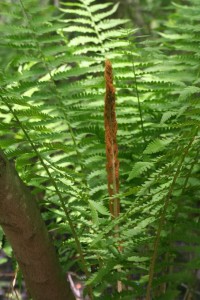 Cinnamon fern grows in wet woods and is good cover for small woodland creatures. Books say that hummingbirds sometimes use the fuzzy young fronds to line their nests. I found these growing on Saturday between visits to Dora at the vet’s in a quiet county park.
Cinnamon fern grows in wet woods and is good cover for small woodland creatures. Books say that hummingbirds sometimes use the fuzzy young fronds to line their nests. I found these growing on Saturday between visits to Dora at the vet’s in a quiet county park.
I like to visit this park because of the variety of habitats. The entrance, with its lined walkway of sycamores, attracts nesting Baltimore and Orchard Orioles. The scrubby fields used to be good for Blue-Winged Warblers, but Saturday I found only one singing his lazy “Beee-buzzzz” song. The dark, wet woods have Wood Thrush and Ovenbirds and many Common Yellowthroats. Most importantly, it is quiet there. No soccer fields, no playgrounds, no bike bath, no planned and managed *open space*. Just nature, without any amenities or improvements.

